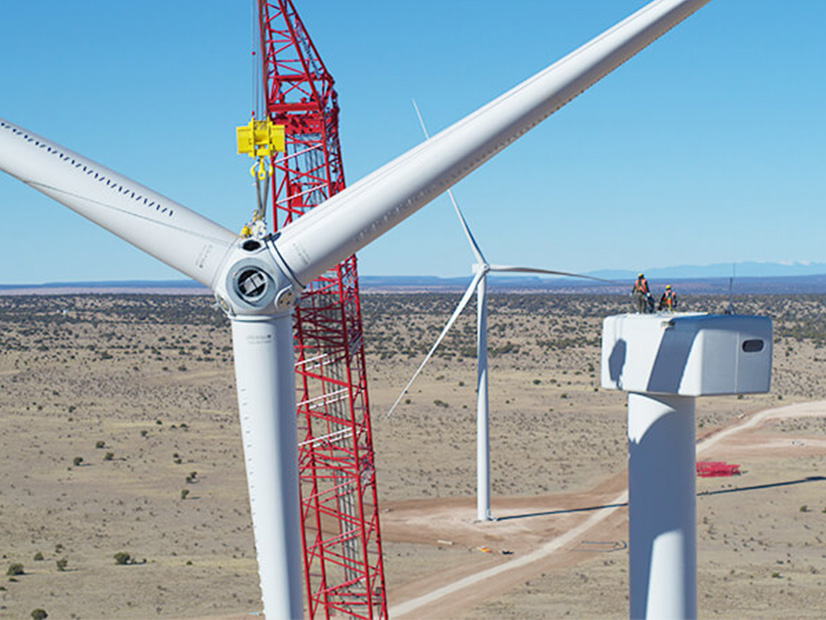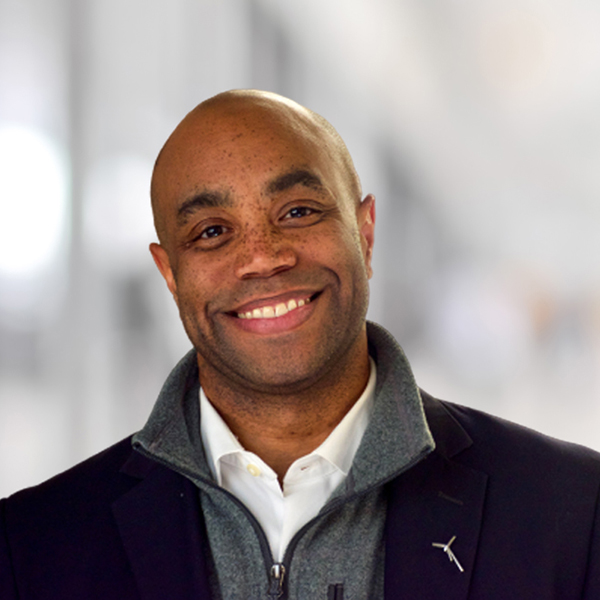
Expansion of the U.S. transmission grid to accommodate decarbonization will require more humility from developers and active support by states, speakers on an Advanced Energy Economy webinar said Tuesday.
The webinar, titled “Making connections: How to get transmission built,” began with a keynote by FERC Chair Richard Glick, who outlined the Notice of Proposed Rulemaking the commission issued April 21 that would require RTOs and ISOs to incorporate scenarios and probabilistic concepts to develop transmission plans looking 20 years into the future. (See FERC Issues 1st Proposal out of Transmission Proceeding.)
Glick noted that the NOPR also would require transmission planners to seek state approval for cost allocation of regional grid projects.
 Sarah Webster, Pattern Energy | Pattern Energy
Sarah Webster, Pattern Energy | Pattern Energy“The states are going to be resistant [to transmission expansion if they think] we’re being unfair and we’re shoving cost on one state versus another state,” he said. “Siting [is] a big example. But states have other abilities as well to prevent their utilities from further developing what in many cases most people would believe is much-needed transmission.”
Glick also highlighted FERC’s Joint Federal-State Task Force on Electric Transmission, which will hold its third meeting on Friday.
“It is absolutely critical that the states … meet the feds halfway to understand what transmission can mean — what grid reliability and deployment of renewables and decarbonization — can mean for the ratepayers and for their voters,” said Sarah Webster, senior vice president of external affairs and market development for Pattern Energy.
A Win in the Southwest
In December, Pattern completed construction of Western Spirit Wind, the largest renewable energy project in the U.S., with four wind farms totaling more than 1,050 MW in central New Mexico.
Pattern built the project to take advantage of New Mexico’s winds, which blow strongest in the morning and night, to complement California’s surfeit of solar power, Webster said. The project’s 377 General Electric wind turbines were accompanied by a 155-mile, 345-kV transmission line that connects with the Public Service Company of New Mexico system near Albuquerque.
“If you want to run a grid on technologies that are reliant on the weather, that’s fine; you can do it in a cost-effective and fully reliable way. But you need a grid that’s bigger than the weather,” she said. “You need the hydro coming in from the Pacific Northwest; you need the wind coming in from the Eastern states; you need the solar that you see in Nevada and California. When you put those all together with some storage and some natural gas for firming and shaping, you’ve got a really reliable baseload-type product energy product.”
But building transmission, she said, “takes patient money” and “a deep engagement with many, many regulatory bodies” and stakeholders.
“The very big reality is, whether we’re doing a 100-mile [transmission] line or a 500-mile [transmission] line, pretty much anyone can stop it. You can have local jurisdiction, county jurisdiction, state jurisdiction. And you don’t typically have condemnation rights.”
Overcoming landowner opposition “takes a lot of engagement. It takes a lot of humility. You’ve got to talk to people from where they’re at. You can’t come in political. You can’t come in with preconceived ideas. You can’t come in even with the implicit idea that this is essential for the greater good. You have to come in, when you’re talking with landowners, profoundly respectful, that you may be dealing with heritage ranches that have been in families for over a century. And you need to be willing to sit down, listen, have hard conversations [and] follow up again.
“And then you have to work with their concerns. … They can say, ‘You know, I am protective of this particular view. Can you work on the routing around this precious part of the land for me?’ And so I think that that’s really the key to engagement.”
Webster said Pattern takes a broad view of its “host community.”
“You’re a host community if you’re hosting an actual facility with turbines or panels. You’re a host community if you’re hosting a substation, or a major piece of transmission infrastructure. But to us, you’re also a host community if you’re supporting the public good by allowing your transmission line to pass through your county or your property. And so we created standardized community benefits packages based on just mileage that [is] consistent across our entire footprint.”
‘Purple Strategy’
One of the keys to the success of Western Spirit’s transmission line, Webster said, was Pattern’s “partnership” with the New Mexico Renewable Energy Transmission Authority (RETA), which does have eminent domain rights. Over the 155-mile route, Webster said Pattern used condemnation “on four parcels in a very non-contested way.”
Webster said other states have taken note of New Mexico’s approach, with Colorado lawmakers recently creating the Colorado Energy Transmission Authority and California considering similar legislation.
“This is not a Democrat thing or Republican thing. I mean, most people don’t realize that 86% of all wind farms in the United States of America are operating in Republican districts,” she said. “This is a purple strategy. Maybe in some states, it’s a renewable energy authority; maybe in others, it’s an infrastructure authority. But it basically empowers the state and its agencies to make some decisions in support of … decarbonization, economics for citizens and economic development.”
Challenges in the Northeast
 Macky McCleary, Guidehouse | Guidehouse
Macky McCleary, Guidehouse | GuidehouseAnother panelist, Macky McCleary, director of energy, sustainability and infrastructure for Guidehouse, discussed the difficulty of siting infrastructure in the Northeast.
“The challenge in highly congested areas like the Northeast is that there’s just no space. And these projects require space, even in states like Massachusetts, which have very lofty, renewable goals,” he said. “They spent 20 years trying to build Cape Wind, which isn’t even on land. They said no to it because they could see it from land in the ocean. To me, that is a great example of how challenged we are going to be. Really the challenge for this is not money; it’s not going to be regulatory. It’s not going to be legal. It’s not going to be capital. It’s going to be political.”
McCleary said FERC’s NOPR is “a potentially really big deal.”
And he said he was cheered that two transmission projects in the Northeast — the Champlain Hudson Power Express, which would deliver 1,250 MW of hydropower to New York City, and the New England Clean Power Link, which would deliver 1,000 MW of power from the Canadian border to Vermont and ISO-NE — will be built.
McCleary said the failure of the Northern Pass project, which would have brough 1,090 MW of Canadian hydropower into New England, helped the Vermont project because of the state’s “culture around renewable energy and the environment.”
The New York project benefited from the “sort of emperor governorship [that] allows them to be able to do some things that other states would not be able to do from a stakeholder point of view … [the] ability to sort of move heaven and earth, because the governor says so.”
Although siting offshore wind is easier than siting land-based projects, McCleary said he is concerned about how the transmission will be designed to deliver their power.
“If we contract out transmission for each individual parcel, we’re going to end up overbuilding transmission for the needs of the entire system. The challenge is that you’re running through several different RTOs here, and it’s not clear whose job it is to ensure that this is done in an efficient way,” he said.
He said he was encouraged by the New York Public Service Commission’s recent order requiring future OSW projects be “mesh ready,” with capacity to connect to a future offshore grid. (See New York Seeks to Protect Tx Options with Mesh-ready OSW.)
“I think it’s necessary for all of the different regulatory bodies to look into this going forward, or we’re going to end up overpaying for this resource that is so abundant off the Atlantic Seaboard.”
Sensors and Markets
Also appearing on the panel was Mona Tierney-Lloyd, head of U.S. and state public policy for Enel North America, who discussed how drought, wildfires and resource adequacy concerns are leading many to consider a potential RTO in the West. (See Western Utilities to Support SPP Market Development.)
An RTO would allow “the coordination of operation across a Western footprint, being able to plan transmission development on a regional basis and the cost allocation of those assets [and to eliminate] pancaked rates, which make it very expensive to move electricity generated in the West from point to point.”
Hilary Pearson, senior director of governmental and regulatory affairs for LineVision, which makes sensors for monitoring transmission line conditions.
Pearson noted the growing use of sensors in medicine, personal fitness and cars. “We’re really excited at the opportunity to help bring some of that data-driven efficiency and visibility [and] consumer benefits to the electric grid.”


